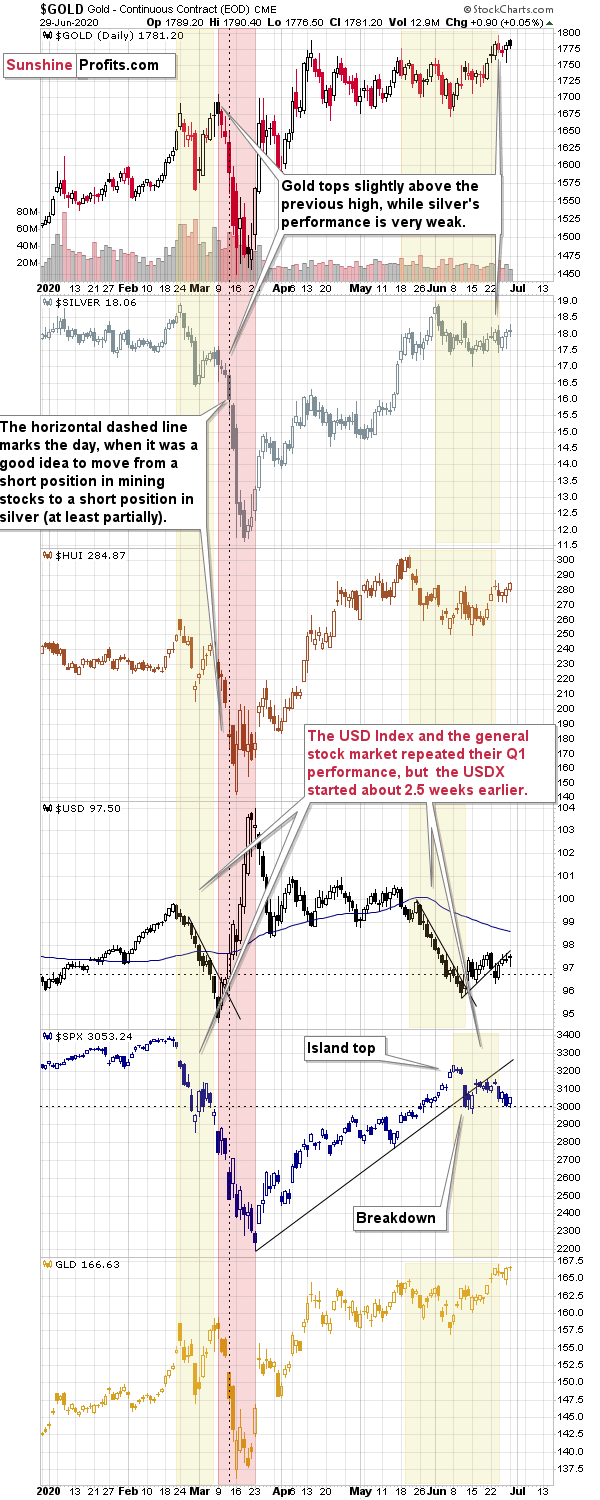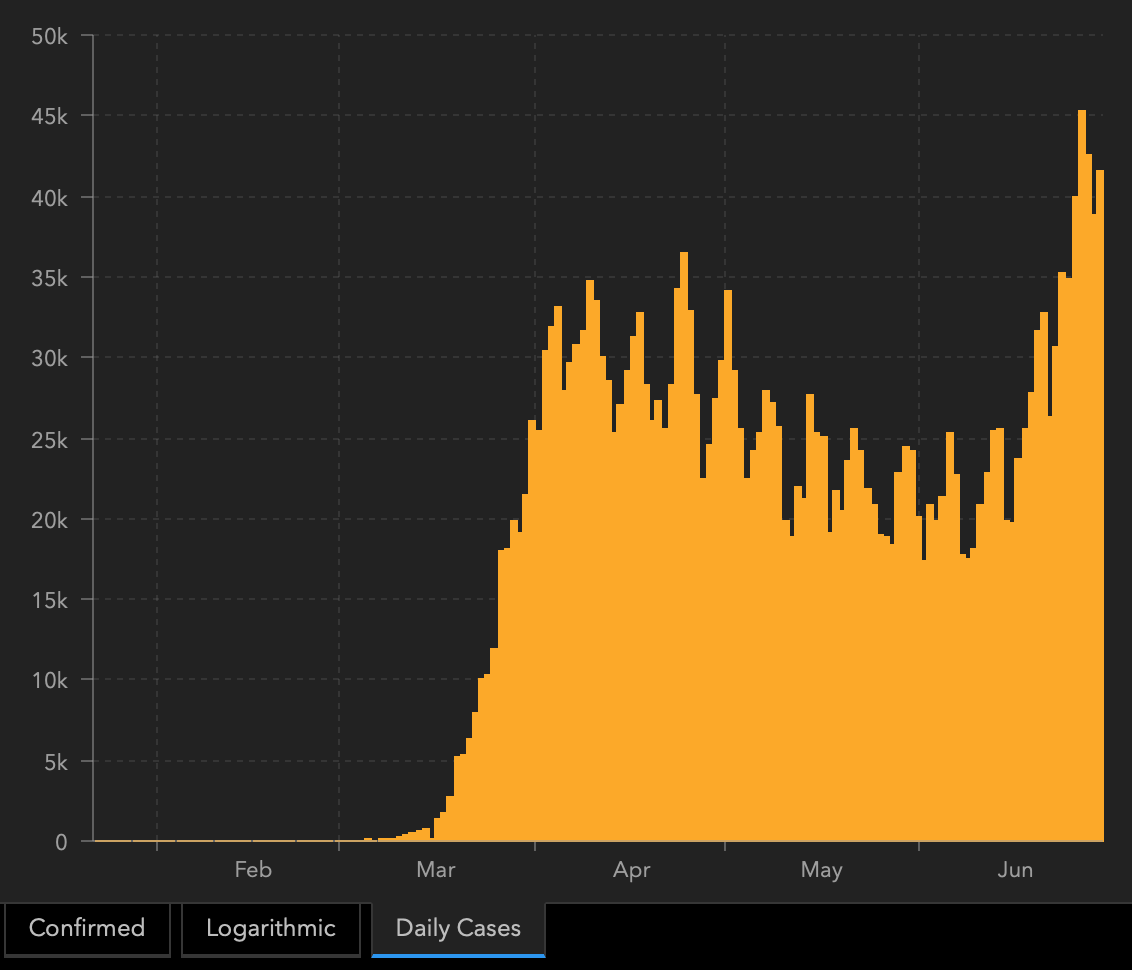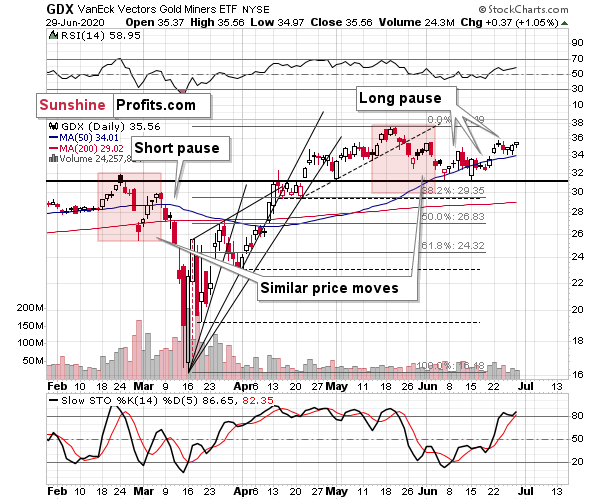Briefly: in our opinion, full (300% of the regular position size) speculative short positions in mining stocks are justified from the risk/reward point of view at the moment of publishing this Alert.
Very little happened on the precious metals market yesterday and the related markets, but it seems that we might see something more interesting today.
The USD Index (third from the bottom) reversed and at the moment of writing these words, it's testing the previous June highs. A clear breakout above these highs might prove to traders that what we've been seeing in the past few weeks is not just a zig-zag correction, but a beginning of a new major rally.
This could trigger - technically - the bigger moves in all markets, not only the USD Index. As the USDX soars, stocks would be likely to slide, and the same fate would be likely for PMs and miners.
There could be - and likely will be eventually - a fundamental trigger for these moves anyway.
The new Covid-19 cases are growing quickly and now only 16 states have the Rt number below 1. In other words, the number of new cases is declining in 16 states, and its growing in the remaining states. The snowball of new cases is growing, and the authorities will have to deal with it in one way or another. The social distancing procedures are being reintroduced only a little, and let's keep in mind that the longer the delay, the more severe the consequences will ultimately be. At some point more serious measures will have to be taken, and they will likely impact the economy to a degree that's much greater than what people are currently expecting. It was when people focused on the dire economic implications of the pandemic and lockdown that the markets really moved, and PMs plunged. We are still before this move.
There's not much more that we can add today as far as chart analysis is concerned, but we would like to reply to the questions that we received recently.
Q: First of all, in 2008, the Fed did not start an aggressive bond buying programs until after the PM and the stock markets tanked. The Fed is now all in and will prevent the market and PM to decline significantly as it did in March.
A: The Fed didn't start the bond buying programs until after the PMs and stock markets tanked in 2008, but it was supposed to be the new shocker back then. What the markets were used to previously were rate cuts, and the Fed had cut those previously - as the prices declined. The markets are now used to both: rate cuts and QEs. And each QE worked less effectively than the previous one.
If the Fed is already all-in, then how will they prevent further shock the market to prevent declines? What new shocker would they provide? By definition, being all in, means that one can't add anything more.
And stocks are likely to slide anyway, because the Fed can't fix the broken supply chains, nor can it make people go out, conduct businesses in the regular way and convince people that "nothing is really going on, you don't have to save your cash for hard times". In 2008, we had liquidity crisis, and the Fed injected liquidity - it helped, but the economic damage was substantial anyway. Right now, we have a different type of crisis. It's not the lack of liquidity that's the problem, but rather the pandemic, which can't be treated with dollars only. The market seems to have assumed that what we saw in March was a one-time event and a bad dream and that all will now be good. And it will be - in a few years. In the meantime, there will be a severe economic slump - much worse than what had already hit the markets, and much worse than what we saw in 2008.
Yet, the stock market didn't decline as low as it did in 2008, while the USD Index didn't rally as high. And gold didn't plunge as low - initially.
The Fed is already all in, while we are not in the situation in which it can really help much, as the problem is not with liquidity. Even though the situation is now much worse than in 2008, the markets have not moved as much as they did back then. This suggests that the markets are still likely to move more (in the directions in which they moved in March), while the Fed won't be able to do much about it. This doesn't bode well for stocks in my opinion. It does bode well for gold, but not initially. During both: 2008 and March 2020 slides, gold showed that it's likely to initially decline along with stocks and along with rising USD Index, and rally only after the decline. The above is very positive for gold, but not initially.
Q: GS now upped its forecast to 2000 and BAC has a 3000 target. Why are you so aggressive in you down side targets? PMs might will touch their march lows, but even that seems impossible given the current circumstances. Why not include some possible interim target prices above your profit-take exit prices in GDXJ and GDX. Will there not be stops along the way.
A: The profit-take exit prices are based on what is really likely to happen in the precious metals sector. It's taking more time than I had originally expected it to, but the stock market is likely to move much lower in my opinion and it's likely to take mining stocks along with them.
As far as interim price targets are concerned, each support level (based on the previous lows and the Fibonacci retracements) could trigger a quick rebound during the decline.
However, the two most important things details are not visible on the above chart.
The first is that we will likely get the opportunity to move from mining stocks to silver as the latter tends to outperform in the final part of a given move. We don't know at what prices it would take place, but we are monitoring the situation for the day (or days) when miners slide very profoundly while silver declines only somewhat. This would likely be the "switch" day. At that time - if we spot this occasion - we would close the position in miners and open one in silver. If it's too unclear, we would likely ride the decline in the miners.
The second thing is the day when gold reverses and moves back up while the USD Index continues to rally. This is what happened in 2008, and what happened in March 2020. It served as a major buy signal, and we expect it to mark the end of the decline also this time. This signal will be more important than the price that gold, silver, or mining stocks have at that time.
Summary
Summing up, the outlook for the precious metals market is extremely bearish for the next 1-3 weeks due to the huge number of bearish signs (and their strength) that we have right now, and how likely PMs are to repeat their March slide to a significant extent). The sharply rising new Covid-19 cases numbers as well as gold's long-term cyclical turning point both suggest that gold's one final slide is just around the corner.
After the sell-off (that takes gold below $1,400), we expect the precious metals to rally significantly. The final decline might take as little as 1-3 weeks, so it's important to stay alert to any changes.
Most importantly - stay healthy and safe. We made a lot of money on the March decline and the subsequent rebound (its initial part) price moves (and we'll likely make much more in the following weeks and months), but you have to be healthy to really enjoy the results.
As always, we'll keep you - our subscribers - informed.
To summarize:
Trading capital (supplementary part of the portfolio; our opinion): Full speculative short positions (300% of the full position) in mining stocks is justified from the risk to reward point of view with the following binding exit profit-take price levels:
Senior mining stocks (price levels for the GDX ETF): binding profit-take exit price: $10.32; stop-loss: none (the volatility is too big to justify a SL order in case of this particular trade); binding profit-take level for the DUST ETF: $231.75; stop-loss for the DUST ETF: none (the volatility is too big to justify a SL order in case of this particular trade)
Junior mining stocks (price levels for the GDXJ ETF): binding profit-take exit price: $9.57; stop-loss: none (the volatility is too big to justify a SL order in case of this particular trade); binding profit-take level for the JDST ETF: $284.25; stop-loss for the JDST ETF: none (the volatility is too big to justify a SL order in case of this particular trade)
For-your-information targets (our opinion; we continue to think that mining stocks are the preferred way of taking advantage of the upcoming price move, but if for whatever reason one wants / has to use silver or gold for this trade, we are providing the details anyway. In our view, silver has greater potential than gold does):
Silver futures downside profit-take exit price: $8.58 (the downside potential for silver is significant, but likely not as big as the one in the mining stocks)
Gold futures downside profit-take exit price: $1,382 (the target for gold is least clear; it might drop to even $1,170 or so; the downside potential for gold is significant, but likely not as big as the one in the mining stocks or silver)
Long-term capital (core part of the portfolio; our opinion): No positions (in other words: cash
Insurance capital (core part of the portfolio; our opinion): Full position
Whether you already subscribed or not, we encourage you to find out how to make the most of our alerts and read our replies to the most common alert-and-gold-trading-related-questions.
Please note that the in the trading section we describe the situation for the day that the alert is posted. In other words, it we are writing about a speculative position, it means that it is up-to-date on the day it was posted. We are also featuring the initial target prices, so that you can decide whether keeping a position on a given day is something that is in tune with your approach (some moves are too small for medium-term traders and some might appear too big for day-traders).
Plus, you might want to read why our stop-loss orders are usually relatively far from the current price.
Please note that a full position doesn't mean using all of the capital for a given trade. You will find details on our thoughts on gold portfolio structuring in the Key Insights section on our website.
As a reminder - "initial target price" means exactly that - an "initial" one, it's not a price level at which we suggest closing positions. If this becomes the case (like it did in the previous trade) we will refer to these levels as levels of exit orders (exactly as we've done previously). Stop-loss levels, however, are naturally not "initial", but something that, in our opinion, might be entered as an order.
Since it is impossible to synchronize target prices and stop-loss levels for all the ETFs and ETNs with the main markets that we provide these levels for (gold, silver and mining stocks - the GDX ETF), the stop-loss levels and target prices for other ETNs and ETF (among other: UGLD, DGLD, USLV, DSLV, NUGT, DUST, JNUG, JDST) are provided as supplementary, and not as "final". This means that if a stop-loss or a target level is reached for any of the "additional instruments" (DGLD for instance), but not for the "main instrument" (gold in this case), we will view positions in both gold and DGLD as still open and the stop-loss for DGLD would have to be moved lower. On the other hand, if gold moves to a stop-loss level but DGLD doesn't, then we will view both positions (in gold and DGLD) as closed. In other words, since it's not possible to be 100% certain that each related instrument moves to a given level when the underlying instrument does, we can't provide levels that would be binding. The levels that we do provide are our best estimate of the levels that will correspond to the levels in the underlying assets, but it will be the underlying assets that one will need to focus on regarding the signs pointing to closing a given position or keeping it open. We might adjust the levels in the "additional instruments" without adjusting the levels in the "main instruments", which will simply mean that we have improved our estimation of these levels, not that we changed our outlook on the markets. We are already working on a tool that would update these levels on a daily basis for the most popular ETFs, ETNs and individual mining stocks.
Our preferred ways to invest in and to trade gold along with the reasoning can be found in the how to buy gold section. Additionally, our preferred ETFs and ETNs can be found in our Gold & Silver ETF Ranking.
As a reminder, Gold & Silver Trading Alerts are posted before or on each trading day (we usually post them before the opening bell, but we don't promise doing that each day). If there's anything urgent, we will send you an additional small alert before posting the main one.
Thank you.
Sincerely,
Przemyslaw Radomski, CFA
Editor-in-chief, Gold & Silver Fund Manager






